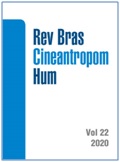Qual a contribuição de cada domínio da atividade física para atividade física total em adolescentes?
DOI:
https://doi.org/10.1590/1980-0037.2020v22e70170Resumo
O presente estudo teve como objetivo verificar a contribuição dos diferentes domínios da atividade física na “atividade física total” em adolescentes brasileiros.Trata-se de estudo transversal utilizando dados secundários oriundos da terceira edição da Pesquisa Nacional de Saúde do Escolar – PeNSE, 2015. A amostra foi constituída por 100.497 adolescentes de ambos os sexos cursando o 9° ano do Ensino Fundamental. Utilizou-se um modelo de regressão linear a fim de averiguar o quanto cada domínio contribuiu para a atividade física total, considerando o sexo, tipo de município e região. O domínio que apresentou maior contribuição para “atividade física total” independentemente das variáveis sociodemográficas e ambientais foram as “atividades físicas extraescolares” (R2= 0,60), seguido do “deslocamento ativo” (R2= 0,34), e por fim as “aulas de Educação Física” (R2= 0,23). A contribuição dos diferentes domínios apresentou variações por sexo, tipo de município e região. Conclui-se que as “atividades extraescolares” apresentam a maior contribuição para a “atividade física total”, seguido do “deslocamento ativo” e das “aulas de Educação Física”. Além disso, verifica-se uma variação na contribuição dos domínios por sexo, tipo de município e região.Referências
Granger E, Di Nardo F, Harrison A, Patterson L, Holmes R, Verma A. A systematic review of the relationship of physical activity and health status in adolescents. Eur J Public Health. 2017;27(2):100–6.
Kyu HH, Bachman VF, Alexander LT, Mumford JE, Afshin A, Estep K, et al. Physical activity and risk of breast cancer, colon cancer, diabetes, ischemic heart disease, and ischemic stroke events: Systematic review and dose-response meta-analysis for the Global Burden of Disease Study 2013. BMJ. 2016;354:1–10.
Telama R, Yang X, Viikari J, Välimäki I, Wanne O, Raitakari O. Physical activity from childhood to adulthood: A 21-year tracking study. Am J Prev Med. 2005;28(3):267–73.
World Health Organization. Global Action Plan on Physical Activity 2018 - 2030. 2018
Silva DAS, Christofaro DGD, Ferrari GL, Silva KS, Nardo N Jr, Silva RJS, et al. Resultados do Boletim Brasileiro de 2018 sobre atividade física para crianças e jovens. J Phys Act Health. 2018;15(2):323-25.
Lonsdale C, Rosenkranz RR, Peralta LR, Bennie A, Fahey P, Lubans DR. A systematic review and meta-analysis of interventions designed to increase moderate-to-vigorous physical activity in school physical education lessons. Prev Med. 2013;56(2):152–61.
Beets MW, Weaver RG, Turner-Mcgrievy G, Huberty J, Ward DS, Pate RR, et al. Making policy practice in afterschool programs: A randomized controlled trial on physical activity changes. Am J Prev Med. 2015;48(6):694–706.
Pizarro AN, Schipperijn J, Andersen HB, Ribeiro JC, Mota J, Santos MP. Active commuting to school in Portuguese adolescents: Using PALMS to detect trips. J Transp Heal. 2016;3(3):297–304.
Slingerland M, Borghouts LB, Hesselink MKC. Physical Activity Energy Expenditure in Dutch Adolescents: Contribution of Active Transport to School, Physical Education, and Leisure Time Activities. J Sch Health. 2012;82(5):225–32.
De Rezende LFM, Azeredo CM, Canella DS, Claro RM, De Castro IRR, Levy RB, et al. Sociodemographic and behavioral factors associated with physical activity in Brazilian adolescents. BMC Public Health. 2014;14(1):1–11.
Instituto Brasileiro de Geografia e Estatística (IBGE). Pesquisa Nacional de Saúde Do Escolar (PeNSE) 2015. IBGE. 2016.16.
Oliveira MM, Campos MO, Andreazzi MAR, Malta DC. características da Pesquisa Nacional de Saúde do Escolar - PeNSE. Epidemiol. Serv. Saúde. 2017;26(3):605–16.
James M, Todd C, Scott S, Stratton G, McCoubrey S, Christian D, et al. Teenage recommendations to improve physical activity for their age group: A qualitative study. BMC Public Health. 2018;18(1):1–9.
Silva M, Engers P, Vilela G, Spohr C, Rombaldi A. Fontes de informação sobre benefícios à prática de atividade física e fatores associados em adolescentes: estudo de base escolar. Rev Bras Atividade Física Saúde. 2016;21(3):237–45.
Smith MP, Berdel D, Nowak D, Heinrich J, Schulz H. Physical activity levels and domains assessed by accelerometry in German adolescents from GINIplus and LISAplus. PLoS One. 2016;11(3):1–17.
Hardie Murphy M, Rowe DA, Woods CB. Impact of physical activity domains on subsequent physical activity in youth: a 5-year longitudinal study. J Sports Sci. 2017;35(3):262–8.
Smith L, Aggio D, Hamer M. Active travel to non-school destinations but not to school is associated with higher physical activity levels in an ethnically diverse sample of inner-city schoolchildren. BMC Public Health. 2017;17(1):1–6.
Larouche R, Sarmiento OL, Broyles ST, Denstel KD, Church TS, Barreira T V, et al. Are the correlates of active school transport context-specific? Int J Obes Suppl. 2015;5(S2):S89–99.
Silva DAS, Chaput JP, Tremblay MS. Participation frequency in physical education classes and physical activity and sitting time in Brazilian adolescents. PLoS One. 2019;14(3):1–14.
Meyer U, Roth R, Zahner L, Gerber M, Puder JJ, Hebestreit H, et al. Contribution of physical education to overall physical activity. Scand J Med Sci Sport. 2011;23(5):600–6.
Aljuhani O, Sandercock G. Contribution of Physical Education to the Daily Physical Activity of Schoolchildren in Saudi Arabia. Int J Environ Res Public Health. 2019;16(13):2397.
Downloads
Publicado
Edição
Seção
Licença

Direitos Autorais para artigos publicados nesta revista são do autor, com direitos de primeira publicação para a revista. Em virtude da aparecerem nesta revista de acesso público, os artigos são de uso gratuito, com atribuições próprias, em aplicações educacionais e não-comerciais, desde que seja dada a atribuição. Esta obra foi licenciada com uma Licença Creative Commons Atribuição 4.0 Internacional - CC BY


